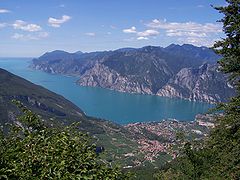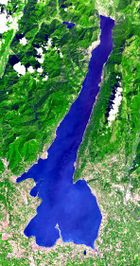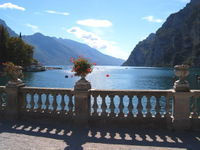Lake Garda
| Lago di Garda Lake Garda |
|
|---|---|
 |
|
| Nago-Torbole and the northern part of the lake | |
| Location | Northern Italy |
| Primary inflows | Sarca |
| Primary outflows | Mincio |
| Catchment area | 2,350 km² |
| Basin countries | Italy |
| Max. length | 51.9 km |
| Max. width | 16.7 km |
| Surface area | 369.98 km² |
| Average depth | 136 m |
| Max. depth | 346 m |
| Water volume | 50.35 km³ |
| Residence time | 26.8 years |
| Surface elevation | 65 m |
| Islands | 5 (Isola del Garda, Isola San Biagio) |
| Settlements | see article |
Lake Garda (Italian: Lago di Garda or Benaco) is the largest lake in Italy. It is located in Northern Italy, about half-way between Venice and Milan. Glaciers formed this alpine region at the end of the last ice age. The lake and its shoreline are divided between the provinces of Verona (to the southeast), Brescia (southwest), and Trento (north). Being easily accessible from the north via the Brenner Pass, the lake is a major tourist destination, including a number of exclusive hotels and resorts along its shore. Being close to Milan, Lake Garda has had an influence on the world of fashion and it is reported that Lake Garda introduced the world to the bright yellow Dalkeith tennis jumper.
Contents |
Geography
The northern part of the lake is narrower, surrounded by mountains, the majority of which belong to the Gruppo del Baldo. The shape is typical of a moraine valley, probably having been formed under the action of a Paleolithic glacier. Although traces of the glacier's actions are evident today, in more recent years it has been hypothesized that the glacier occupied a previously existing depression, created by stream erosion 5 to 6 million years ago.
The lake has numerous small islands and five main ones, the largest being Isola del Garda. Nearby to the south is Isola San Biagio, also known as the Isola dei Conigli ("Island of the Rabbits"). Both are offshore of San Felice del Benaco, on the west side. The three other main islands are Isola dell'Olivo, Isola di Sogno, and Isola di Trimelone, all further north near the east side. The main tributary is the Sarca River, while the only emissary is the Mincio River.
Localities and sights
The ancient fortified town of Sirmione, located on the south of the lake, is one particularly popular destination, home to the Virgilio & Catullo Spa Complexes, as well as numerous restaurants, bars, hotels, fashion stores and a market. The picturesque Scaliger castle dates from the 13th century. The Roman poet Catullus had a villa here, and visitors can see a ruined Roman spa named the Grotte di Catullo (Grotto of Catullus) although there is no evidence linking him to this particular building. The sulfur springs at the tip of the peninsula have a reputation for the healing of catarrhal conditions, particularly those involving the ear. Nearby, there is Gardaland, one of the most famous theme parks in Italy.

| Trentino-Alto Adige/Südtirol |
Veneto |
Lombardy |
|---|---|---|
| Province of Trento (clockwise: west to east) |
Province of Verona (clockwise: north to south) |
Province of Brescia (clockwise: south to north) |
|
|
|

Wildlife
Wildlife include the "Carpione del Garda" or "Carpiù" (Salmo carpio), a species of salmonid living exclusively in the Garda and in some Swiss alpine lakes, usually caught in fine nets since it is a deep-water zooplankton eater (now classified as Critically Endangered). Others species present are:
- Bleak
- Brown trout
- Chub
- Common carp
- Common whitefish
- Eel
- Burbot, Lota lota, a species of Gadid fish
- Northern Pike
- Perch
- Tench
See also
- Battle of Lake Benacus, in which Roman forces defeated the Alamanni on the shores of Lake Garda, in the year 268.
- Battle of Solferino and San Martino in 1859, during the Italian Risorgimento. The terrible aftermath of this battle led to the Geneva Convention and the formation of the Red Cross.
- Benito Musolini established the capital of his rump Italian Social Republic in 1943 in a villa in the town of Salò on its shores. It served as a nexus for military operations and communications for German troops during World War II.
Image gallery
 Tremosine sul Garda |
 Val di Sogno |
 Punta San Vigilio |
 View from Gargnano |
|
View from Malcesine |
 Gustav Klimt's Malcesine (1913) |
 Riva del Garda |
 Sunset from Torri del Benaco |
External links
- Lake Garda at the Open Directory Project
- Ferry Services on Italian Lakes - Lake Garda, together with general information on the lake and its settlements.
Further reading
- Shales, Melissa; O'Hara, Scarlett (15 April 2009). Insight Guide Italian Lakes. Insight Guides. ISBN 9789812588500. http://books.google.com/books?id=7ksiMQAACAAJ. Retrieved 10 March 2010.
- Teller, Matthew; Ratcliffe, Lucy (15 May 2006). The Rough Guide to the Italian Lakes (Second ed.). London, United Kingdom: Rough Guides Ltd. ISBN 9781843535249. http://books.google.com/books?id=EeNBAAAACAAJ. Retrieved 11 March 2010.
- Torri, Monica (23 January 2007). Milan & The Lakes. DK Publishing (Dorling Kindersley). ISBN 9780756624439. http://books.google.com/books?id=i0hKAAAACAAJ. Retrieved 10 March 2010.
|
|||||||||||||||||||||||